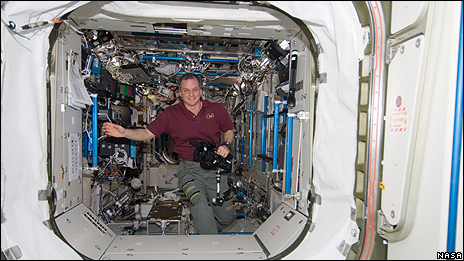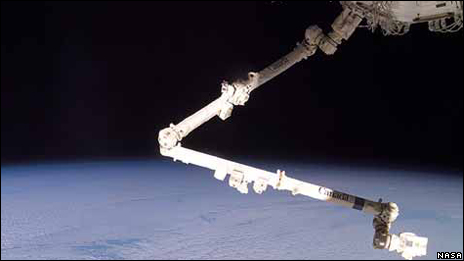Explore the Space Station
To coincide with the 50th anniversary of the first manned spaceflight, BBC News presents a guide to the International Space Station (ISS), the biggest orbiting platform ever built for humans. The ISS began operating as a giant orbiting research laboratory in November 2000, when the first crew took up residence. Many countries have contributed components to the ISS, which is supposed to be completed some time in 2012 and to remain in operation for at least another three years.

Kibo
 Japan's Kibo science module has a so-called "porch" where experiments are exposed to the harsh environment of space and then retrieved via a robotic arm or spacewalk. Kibo is the largest single ISS module, measuring some 11m (36ft) in length.
Japan's Kibo science module has a so-called "porch" where experiments are exposed to the harsh environment of space and then retrieved via a robotic arm or spacewalk. Kibo is the largest single ISS module, measuring some 11m (36ft) in length.
Harmony
 Built in Italy for the United States, Harmony is a hi-tech hallway that connects the US Destiny lab to the European Columbus lab. It also provides connecting ports and the station's robotic arm can operate from a fixture on the outside of Harmony.
Built in Italy for the United States, Harmony is a hi-tech hallway that connects the US Destiny lab to the European Columbus lab. It also provides connecting ports and the station's robotic arm can operate from a fixture on the outside of Harmony.
Columbus
 The Columbus lab is the European Space Agency's largest single contribution to the space station. Communication links to controllers and researchers on Earth will enable scientists to participate in their own experiments in space from several user centres. The control centre is based in Germany.
The Columbus lab is the European Space Agency's largest single contribution to the space station. Communication links to controllers and researchers on Earth will enable scientists to participate in their own experiments in space from several user centres. The control centre is based in Germany.
Destiny
 The US research lab, Destiny was delivered the space station in 2001. Crew members use it to carry out a wide range of experiments. It also has a window for taking high quality photos and videos.
The US research lab, Destiny was delivered the space station in 2001. Crew members use it to carry out a wide range of experiments. It also has a window for taking high quality photos and videos.
Mobile servicing station
 Canada has contributed an essential component of the International Space Station, the Mobile Servicing System. This robotic system plays a key role in space station assembly and maintenance: moving equipment and supplies around the station, supporting astronauts working in space, and servicing instruments and other payloads attached to the space station. Astronauts receive robotics training to enable them to perform these functions with the arm.
Canada has contributed an essential component of the International Space Station, the Mobile Servicing System. This robotic system plays a key role in space station assembly and maintenance: moving equipment and supplies around the station, supporting astronauts working in space, and servicing instruments and other payloads attached to the space station. Astronauts receive robotics training to enable them to perform these functions with the arm.
Solar panels
 The space station runs on solar power. It has four large sets of solar panels, each wing is 34m (112ft) long by 12m (39ft) wide. The eight solar arrays generate 84 kilowatts or 112 horse power - a laptop uses between 15 and 45 watts.
The space station runs on solar power. It has four large sets of solar panels, each wing is 34m (112ft) long by 12m (39ft) wide. The eight solar arrays generate 84 kilowatts or 112 horse power - a laptop uses between 15 and 45 watts.
Zarya equipment room
 The US-funded and Russian-built Zarya, which means "Sunrise" when translated into English, is a US component of the station, although it was built and launched by Russia. It was the first component launched for the ISS, designed to provide its initial propulsion and power.
The US-funded and Russian-built Zarya, which means "Sunrise" when translated into English, is a US component of the station, although it was built and launched by Russia. It was the first component launched for the ISS, designed to provide its initial propulsion and power.
Radiators
 The radiators built for the space station are designed to reject heat, thereby providing cooling to the crew compartment, spacecraft subsystems and experiments. The radiator panels are made of an aluminum bonded honeycomb material and are painted with a white ceramic material selected to withstand the space environment.
The radiators built for the space station are designed to reject heat, thereby providing cooling to the crew compartment, spacecraft subsystems and experiments. The radiator panels are made of an aluminum bonded honeycomb material and are painted with a white ceramic material selected to withstand the space environment.
Soyuz
 The Russian Soyuz space capsule took the first crew to the space station in November 2000. At least one Soyuz has always been docked at the space station to be used as a means of escape in an emergency. The return journey to Earth takes 3.5 hours.
The Russian Soyuz space capsule took the first crew to the space station in November 2000. At least one Soyuz has always been docked at the space station to be used as a means of escape in an emergency. The return journey to Earth takes 3.5 hours.
Zvezda crew quarters
 The Russian Zvezda module provides living quarters for the crew, including sleeping quarters, a toilet and hygiene facilities, a kitchen with fridge-freezer and a table. There is also exercise equipment including a treadmill and exercise bike.
The Russian Zvezda module provides living quarters for the crew, including sleeping quarters, a toilet and hygiene facilities, a kitchen with fridge-freezer and a table. There is also exercise equipment including a treadmill and exercise bike.
Progress supply ship
 The spacecraft is used for taking food and supplies to the space station. It can carry up to 1,760kg (3750lb) of supplies and up to 1,740kg (3840lb) of fuel. It normally docks with the Zvezda module but can attach elsewhere. The crew empty the cargo, replacing it with rubbish and equipment they no longer need which burns up with Progress on re-entry to the Earth's atmosphere.
The spacecraft is used for taking food and supplies to the space station. It can carry up to 1,760kg (3750lb) of supplies and up to 1,740kg (3840lb) of fuel. It normally docks with the Zvezda module but can attach elsewhere. The crew empty the cargo, replacing it with rubbish and equipment they no longer need which burns up with Progress on re-entry to the Earth's atmosphere.
Features
-
IS in Europe: The race to the death
Tuesday's devastating attacks in Brussels show IS's European network is still at large, despite a year of intensive efforts by security forces to close it down.
-
Project Greenglow and the battle with gravity
Scientists are debating whether it's possible to harness the power of gravity for interstellar space travel.
-
The boy who refused to leave police custody
The four-year-old boy who has become the centre of a controversy between India and Pakistan - and between his father and mother.
-
The mirth and misogyny of Andy Capp
Why, almost 60 years after he first appeared in the Daily Mirror, is a layabout lout from north-east England still so loved around the world?
~RS~q~RS~~RS~z~RS~08~RS~)

 Drones bounce back from collisions
Drones bounce back from collisions